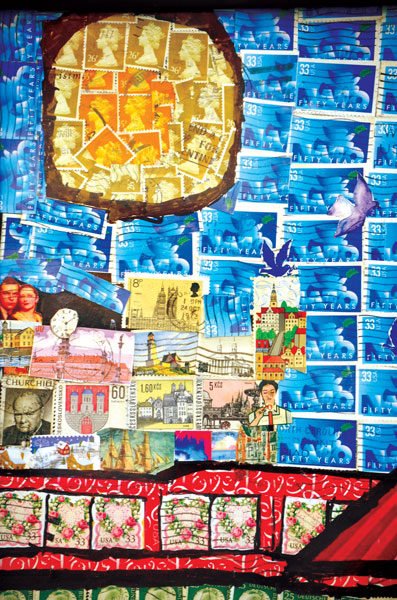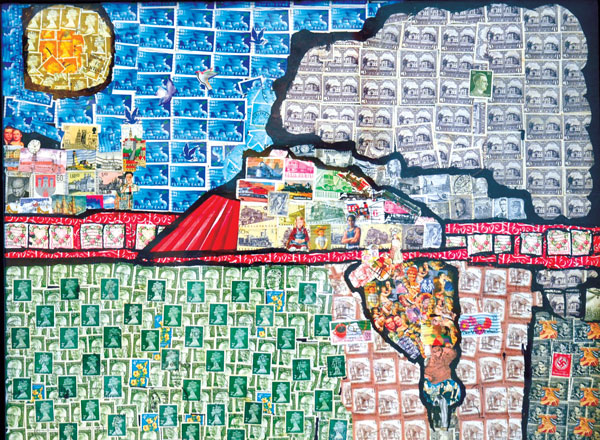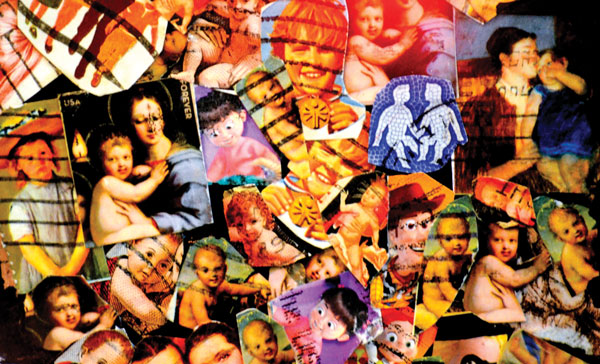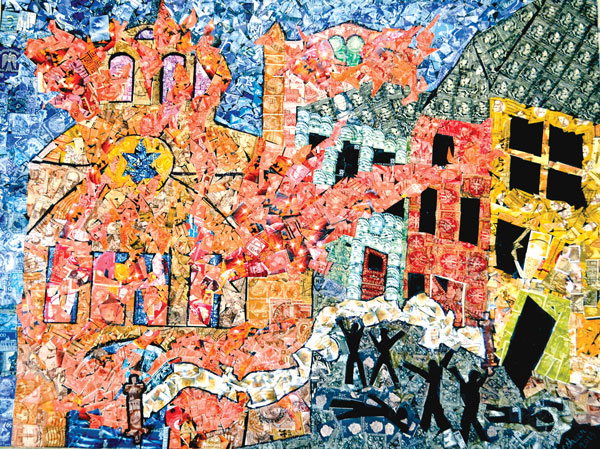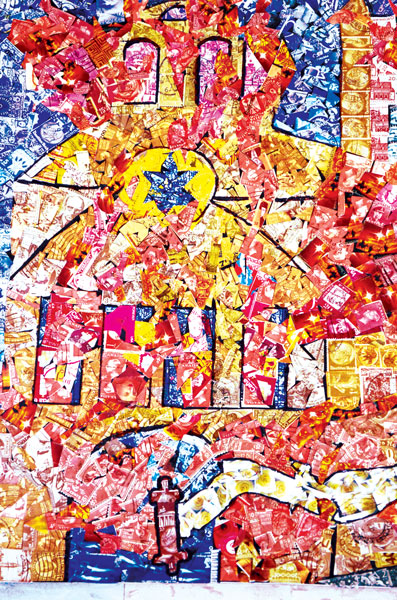Millions of Stamps Teaching
“Countless Lessons in Tolerance”
Charlotte Sheer, Founder, Holocaust Stamps Project, Retired educator
Foxborough Regional Charter School, Foxboro, MA
Stamps collected to date: 10 million
Introduction
In 2009, fifth grade students at Foxborough Regional Charter School (FRCS) began collecting cancelled postage stamps. But these young people were not aspiring to become junior philatelists. They were the first participants in a hands-on exercise designed to visually represent the enormity of 11 million lives senselessly and tragically wiped out by the Nazis during World War II.
Today, the Holocaust Stamps is a Community Service Learning component at FRCS. It serves as an educational springboard for history-based lessons about the dangers of prejudice and discrimination as well as the importance of practicing tolerance and developing respect for differences.
In August, 2013 the SIP journal article “Collecting Millions of Stamps” (p. 140) detailed the origin and evolving goals of the ongoing Project at this kindergarten to grade 12 public school in Foxboro, Massachusetts. The student population represents a demographically and culturally diverse cross section from more than 20 area communities, making FRCS an especially appropriate venue for such an ambitious anti-bullying initiative.
The students and adult volunteers who trim, sort, and count the stamps donations often comment on the variety of philatelic images depicting people, places, historical themes, and human values. Ironically it was Hitler’s lack of respect for diversity and his intolerance for differences that resulted in the Holocaust.
An important part of the Holocaust Stamps Project (HSP) is that middle and high school students have opportunities to express their evolving understanding of the events and effects of the Holocaust. This is accomplished through teacher-directed classwork, participation in an HSP club, and in small, supervised groups where students use thousands of the stamps to design and create original collage artworks. Since 2012, the young artists have completed ten Holocaust-themed pictures entirely out of stamps, two of which were finished during the 2013-2014 school year.
Kinder Train
Kindertransport Design
The Kindertransport design was inspired by an April, 2012 visit to the school by Mrs. Eva Paddock. She was just four years old when she and her nine–year old sister were put on one of (Sir) Nicholas Winton’s rescue trains by their parents for the long journey from Prague, Czechoslovakia to London prior to the outbreak of World War II in 1939.
Three freshman students conceptualized the interpretive design to represent this extraordinary humanitarian effort which rescued 669 mostly Jewish Czech children from the reach of the Nazis. Elsewhere in Europe nearly 10,000 more youngsters were saved via kindertransports arranged by other courageous rescuers. Sadly, only Sweden and England were willing to take in the young refugees, with the latter sheltering the majority of them.
The young artists selected stamps with images of children and parents to represent the emotional scene at a train platform where family members would have been separated from their dear kinder, hoping for safe passage into the hands of benevolent strangers in England. The United Kingdom’s stamps in the collage honor all those who opened their homes and hearts to the thousands of European refugee children, most of whose parents perished in the concentration camps.
The focal point of the Kindertransport collage is a steam engine traveling along a colorful track formed by Love stamps. While blue NATO “peace dove” stamps fill the sky ahead of the engine, the visual storyline also includes philatelic images of Hitler and the swastika. In completing this unique artwork, the students demonstrated incredible compassion and understanding of the subject.
Kinder Transport Train
The Children
Crystal Night
Star of David
Kristallnacht Design
In February, 2014, after more than a year of work, sophomore Nathan O’Connor put the finishing touches on the Holocaust Stamps Project collage entitled Kristallnacht: The Night of Broken Glass. Nate was part of the original student group that had begun the artwork 13 months earlier, during the week of United Nations International Holocaust Remembrance Day (https://www.un.org/en/holocaustremembrance/). The design recalls the horrors of the well–organized November 9, 1938 overnight attack on Jews living under the rule of the Third Reich in Germany and Austria.
“I have a passion for history, specifically (having) to do with World War II,” said Nate, whose involvement with the Holocaust Stamps Project dates back to when he was in the fifth grade class where it began five years ago. He had already trimmed and counted thousands of the donated stamps prior to his HSP Student Life club work on the Kristallnacht collage.
With literally millions of stamps to consider before they could start work on the collage, it seemed serendipitous that the students came across one with the brilliant, multi–colored image of a stained glass window created by Jewish artist Marc Chagall. The window, installed at the United Nations building, honors Nobel Peace Prize winner UN Secretary General Dag Hammarskjold. They used the cut–up pieces of the Chagall stamp to symbolically represent the shattered windows in one of the 267 synagogues torched and destroyed during Kristallnacht.
Nate chose to leave black, empty spaces in the windows of the non–synagogue buildings to represent the families for whom the light of life was extinguished that night. He also felt that there should be a sense of hollowness in the human figure outlines in the streets. The ghostly shapes honor the memories of those who were either killed on the spot or were marched off to concentration camps.
The heart-wrenching effects of this all night hate–driven attack is further illustrated by the presence of a desecrated Torah scroll unfurled in the street outside the sanctity of a burning synagogue.
Lessons Learned
As a result of working on the Holocaust Stamps Project, Nathan O’Connor says he has “learned that we have people in our school whose family members were personally affected (by the events of the Holocaust).” He continues,
“The Stamps Project has made me more tolerant of others (because it) emphasizes the need for tolerance in our society. With such a diverse population, there are so many different groups that need to be accounted for.”
As the 2014–2015 school year gets underway, the Holocaust Stamps Project enters its sixth year. Several generous Society of Israel Philatelists members have already donated thousands of stamps from their personal collections. Stamp clubs across the country, as well as church, synagogue, and civic groups, businesses, schools, non–profits, and hundreds of individuals helped the total number of stamps grow to more than 3, 888,000 –about 35% of the Project’s goal – as of the last day of school in June (2014).
Nate feels very strongly about the relevance of this unique educational initiative. “The (Holocaust) Stamps Project is such a great learning experience,” he says, “and while we are losing the most resilient generation, people are going to forget about the Holocaust eventually. The Project is a good way to keep the memories of the victims alive.”
Further Information
More information about, and photos related to, the Holocaust Stamps Project can be found on the website:
http://www.foxboroughrcs.org/students–families/frcs–holocaust–stamp–project/
Holocaust Stamps Project, Foxborough Regional Charter School, 131 Central Street, Foxboro, MA 02035
Questions and comments? Please contact Holocaust Stamps Project facilitator, Mrs. Jamie Droste (jdroste@foxboroughrcs.org), Student Life Advisor.
Part of the Foxborough Regional Charter School’s mission is to “promote positive ethical, moral, and civic values and prepare students to serve their respective communities as leaders and good citizens.”

